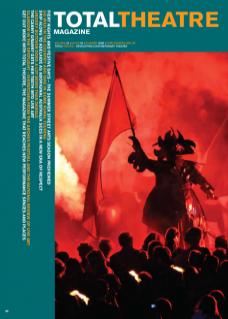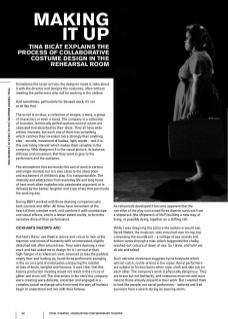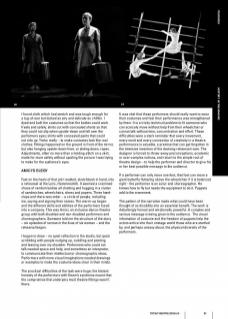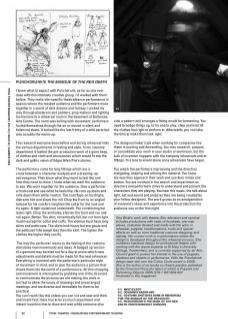Sometimes the script arrives, the designer reads it, talks about it with the director and designs the costumes, often without meeting the performers who will be working in the clothes.
And sometimes, particularly for devised work, it’s not at all like that.
The script is an idea, a collection of images, a story, a group of characters or even a mood. The company is a collection of inventive, technically skilled workers most of whom are obsessed and absorbed by their ideas. They all have wide artistic interests, but each one of them has something which catches their invention more strongly than anything else – sounds, movement of bodies, light, words – and it is this overriding interest which makes them valuable to the company. With designers it is the visual picture; its balance, stillness and movement, that they want to give to the performers and the audience.
The atmosphere that surrounds this sort of work is serious and single-minded, but it is also close to the absorption and excitement of children’s play. It is companionable. The intensity and abstraction from everyday life and long hours of hard work often explodes into passionate argument, or is defused by the banter, laughter and cups of tea that punctuate the working day.
During 2007 I worked with three devising companies who both connect and differ. All three have movement at the heart of their creative work, and combine it with soundscape and visual effects, and to a lesser extent words, to form the narrative drive of their performance.
OCKHAM’S RAZOR’S ARC
Ockham’s Razor use theatre, dance and circus to look at the manners and mores of humanity with an interested, slightly detached and often amused eye. They were devising a new work and had asked me to design for it. I arrived at their high-hangar of a rehearsal room, bounced across the padded, empty floor and looking up, found three performers swinging in the air on a grid of metal poles comparing the relative virtues of knots, weights and humans. It was clear that this bizarre production meeting would not result in the circus of glitter and drum-roll. The characters in the story the company were creating were delicate, uncertain and engaged in a complex, social exchange which mirrored the way all humans begin to understand and live with their fellows.
As rehearsals developed it became apparent that the narrative of the play concerned three diverse survivors from a shipwreck (the shipwreck of life?) building a new way of living, or possibly dying, together on a drifting raft.
While I was imagining the picture the audience would see, Derek Nisbet, the musician, was crouched over his lap-top composing the soundtrack – a collage of sea sounds and broken tunes through a mist, which suggested the chalky, washed-out colours of dawn at sea. So I drew, and later we all ate and talked.
Such extreme movement suggests Lycra bodysuits which will not catch, ruckle or bind in the ropes. Aerial performers are subject to friction burns when rope, cloth and skin rub on each other. The company’s work is physically dangerous. They are brave but not foolhardy, and costumes must not add more risks to those already present in their work. But I wanted them to look like people, not aerial performers – tattered and frail survivors from a wreck during an evening storm.
I found cloth which had stretch and was tough enough for a tug-of-war but looked as airy and delicate as chiffon. I dyed and built the costumes so that the bodies could work freely and safely: skirts cut with concealed shorts so that they could not slip when upside-down and fall over the performers eyes; shirts with concealed pants that could not ride up. Tricks really – to make costumes look like real clothes. Fittings happened on the ground in front of the mirror, but also hanging upside-down from, or sliding down, ropes. Adjustments, often no more than a holding-stitch on a skirt, made for more safety without spoiling the picture I was trying to make for the audience’s eyes.
AMICI’S ELEGY
Fast on the heels of that job I walked, sketchbook in hand, into a rehearsal at the Lyric, Hammersmith. It seemed a crammed chaos of random bodies all chatting and hugging in a clutter of sandwiches, wheelchairs, shoes and papers. Three handclaps and there was order – a circle of people, including me, saying and signing their names. The warm–up began and the different skills and abilities of the performers fused into a company. This was Amici, an inclusive dance-theatre group with both disabled and non-disabled performers and choreographers. Someone told me the structure of the story – six episodes of sorrow in the lives of six women – and the rehearsal began.
I began to draw – no quiet reflection in the studio, but quick scribbling with people nudging up, cuddling and pointing and leaning over my shoulder. Performers who could not talk needed space and help, and sometimes an interpreter, to communicate their intellectual or choreographic ideas. Performers with more visual imaginations needed drawings or examples to make the costume ideas clear in their minds.
The practical difficulties of the task were huge; the blatant honesty of the performers with Down’s syndrome meant that the compromise that underpins most theatre fittings wasn’t there.
It was vital that these performers should really want to wear their costumes and feel their performance was strengthened by them. It is a tricky technical problem to fit someone who can scarcely move without help from their wheelchair or cannot talk without time, concentration and effort. These difficulties were a stark reminder that every movement, every word and every connection of creativity in a theatre performance is valuable, a premise that can get forgotten in the intensive invention of the devising rehearsal room. The designer is forced to throw away preconceptions, academic or over-complex notions, and return to the simple root of theatre design – to help the performer and director to give his or her best possible message to the audience.
If a performer can only move one foot, that foot can move a giant butterfly fluttering above the wheelchair if it is balanced right – the performer is an actor and choreographer. He knows how to fly but needs the equipment to do it. Puppets add to the movement.
The pattern of the narrative made what could have been thought of as disability into an essential benefit. The work is disturbingly honest and emotionally powerful. A complex and serious message is being given to the audience. The visual information of costume and the freedom of puppets help the actors entice into their onstage world those who are startled by, and perhaps uneasy about, the physical diversity of the performers.
PUNCHDRUNK’S THE MASQUE OF THE RED DEATH
I knew what to expect with Punchdrunk, as far as one ever does with this intensely creative group. I’d worked with them before. They make site-specific theatre/dance performance in spaces where the masked audience and the performers move together in a world of dark dreams and fantasy. I picked my way through plasterers and painters, prop-makers and lighting technicians to a rehearsal room in the basement of Battersea Arts Centre. The room was boiling with movement: performers hurled themselves through the air or moved in silent and balanced duets. It looked like the last frenzy of a wild party but was actually the warm-up.
The research everyone does before and during rehearsal links the various departments in feeling and style. In my costume department it fuelled the pre-production work of a giant heap of clothes and cloth and accessories which would fit into the dark and gothic vision of Edgar Allen Poe’s stories.
The performers come for long fittings which are a cross between a character analysis and a dressing–up extravaganza. They know what they want to feel like and how they need to move. I know what we want the audience to see. We work together for the audience. Give a performer a frockcoat and see what he feels like. He runs up stairs and rolls down them while I watch. The coat flaps on his thighs, distracts him and slows the roll. Chop the front to an angled tailcoat for his comfort, heighten the collar for the look and try again. A tight waistcoat underneath. Too constricting but looks right. Chop the armholes, shorten the front and run and roll again. Better. The shirt, romantically full, but cut from light muslin except for collar and cuffs. The women must have long skirts and petticoats. The skirts look heavy but are gauze and the petticoat frills weigh less than the skirt. The lighter the clothes the higher they can fly.
The way the performer reacts to the feeling of the costume stimulates new movements and ideas. A bodged up version of a garment may be tried out for a day to prove which new adjustments and details must be made for the next rehearsal. Everything is invented with the performer’s particular style of movement in mind, and to give the audience a picture that draws them into the world of a performance. All this chopping and movement is interrupted by grabbing one of the directors to communicate the pictures we are making; the work is too fast to allow the luxury of drawings and prearranged meetings, and too diverse and immediate for them to be practical.
You can’t work like this unless you can cut and sew and think and invent fast; there has to be so much experiment and instant invention that to draw and wait while someone else cuts a pattern and arranges a fitting would be tormenting. You need to bodge things up, to try and to play, chop and knot till the clothes feel right to perform in. Afterwards you can take the time to make them look right.
The designer/maker’s job when working for companies like these is exciting and demanding. You may research, prepare or consolidate your work in your studio or workroom, but the bulk of invention happens with the company rehearsals and at fittings. It is rare to invent alone once rehearsals have begun.
You watch the performers improvising and the directors instigating, shaping and refining the material. You know the way they approach their work and use their minds and bodies. You are involved in the search and experiment as directors and performers strive to understand and present the characters they are playing. You hear the music, the talk about light, set and sound and props as they are being created by your fellow designers. The work grows as an amalgamation of everyone’s ideas and experience into the production the audience see on the first night.
Tina Bicât’s work with theatre, film, television and carnival includes productions with casts of hundreds, one-man shows, costumes devised and made with the actor in rehearsal, puppets, transformations, tricks and special effects as well as more traditional costume designing and making. Her current work is in performance where the design is developed throughout the rehearsal process. She combines freelance design for professional theatre with working with the drama students at St Mary’s University College, Twickenham, and is currently supported by an Arts Council grant to pursue her interest in the use of puppets, shadows and objects in performance. With the Punchdrunk design team she won the Critics Circle award in 2006. She is the author of six books on theatre practice published by the Crowood Press the latest of which is Puppets and Performing Objects ISBN 978-1-861269-607 (reviewed in this magazine).



